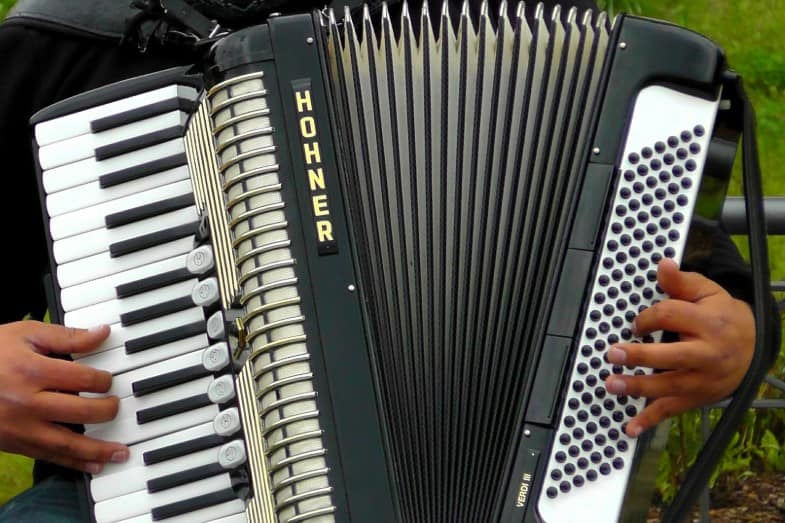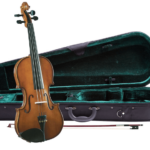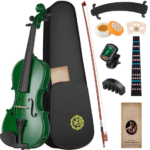Of all the different orchestral instruments, the violin is probably the most recognizable. What many don’t know is that there are several different types of violins. What are the different types of violins?
There are 10 violin types based on the genre and time period. These 10 types are as follows:
- Classical Type Violin
- Electric Type Violin
- Electric-Acoustic (or Semi-Acoustic Violin)
- Viola
- Pre-Baroque Stringed Instrument
- Baroque Type Violin
- Stroh Type Violin
- Silent Type Violin
- Five String Type Violin
- Fiddle
Another way to differentiate violins into types is to look at the varying sizes. Choosing the right size is important as the perfect violin size will depend on the artist’s arm length.
Options are available for children and adult players based on recorded fractions that differentiate the sizes. These options are called Fractional Violins. Some of the more common violin sizes are 1/16, 1/8, and 1/10. We will discuss more of this in the sections to come.
Read on to learn more about the different types of violins and their features.
Also, we hope you find the links here useful. We may get a commission if you purchase something through a link on this page, so thank you!
Types of Violins

According to National Geographic, the inspiration for the modern violin that we know now came from the early 16th-century’s fiddle. From then on, it has transformed into the many different types of violins we know today to cater to varying players’ needs.
Click here to see this Violin 4/4 Full Size Set on Amazon.
Violins can be classified into three main categories:
- Genre
- Time Period
- Size
These categories are not the only definitive classifications of violin types, but they make it easier for the aspiring violinist to understand its history.
1. Classical Type Violin
It might be called such, but the classical violin is actually the modern violin we know today. People also sometimes call this violin acoustic. Vivaldi and Bach used to utilize this violin in grand violin concertos of yesteryears.
Come the 18th and 19th centuries, new bowing techniques arise. This led to an increase in violin designs’ string tension, consequently changing the violin’s range and sound projection.
Ultimately, this design change is what made the Classical Violin stand out amongst all other types.
Regarding its physical attributes, the Classical Violin has a high-level string tension coupled with a slender neck. It can also hold better quality strings and rosins, which greatly help this violin type’s sound production.
With the Classical Violin, violinists can also enjoy more comfortable fittings, such as the chin rest. Ultimately, the Classical Violin is indeed the standard used by expert violinists to assess other violin types.
2. Electric Type Violin
As the name suggests, electric-type violin produces sound electronically, and they do not require the use of a soundbox or even f-holes to create sound. As a result, people created many designs and models.
The first official electric violin was sold in the 1930s, but musicians have played violins with pickups long before then. Apart from all violin types, its advantage is that it offers distortion of sound through amplification.
Pedals and other electronics can aid in the distortion process, helping musicians in their quest to innovate music.
This is why electric violins have continually gained popularity throughout the years, especially for the younger generations. It has become a common addition to bands of different genres and provides another layer of sound and texture to their overall music.
3. Electric-Acoustic Type Violin
The Electric-Acoustic type violin is basically a traditional violin with a pick-up. This is the reason why it is also called the Semi-electric violin. Fitting a pick-up allows a traditional violin’s sound to be amplified electronically and with the help of other musical gears.
But unlike a fully electric violin, the semi-electric maintains the acoustic sound and feel even when attached to an amplifier.
Once you plugged this into an amplifier, it won’t be loud because it retains its acoustic sound. Unlike bass or electric guitars, wherein the sound becomes exponentially louder once plugged in.
There are models of classical violins that are easily modifiable to become semi-electric. But other models require slight to major modifications to be able to fit a pick-up successfully.
4. Viola
Among all types of violins, Viola is the most ideal for adult learners. Most beginners prefer this as it is best when playing in a group setting, and the scores are easier over a wider range of music genres.
It is very similar in play as the regular violin except that it creates a slightly lower and louder sound.
The Viola follows the middle voice in an orchestra, so it is a popular instrument for many composers and solo concerts. It produces deep and warm tones that can easily complement other instruments to create a well-rounded sound.
5. Pre-Baroque Stringed Instruments
Long before the violin’s invention, we know today that stringed instruments of the pre-Baroque era were common. One such instrument is the three-stringed Violetta, quite similar to a violin but with its own unique merits.
Some enthusiasts consider pre-baroque stringed instruments as the earliest violin types, and to some extent, maybe they are. The difference is, pre-baroque stringed instruments such as the three-stringed Violetta is held upright while using the chin to hold it in place.
6. Baroque Type Violin

Created around the 16th century, the Baroque Type Violin is considered the first-ever standardized violin. A musical revolution rose during this period, which saw a surge in the production of stringed instruments. To this day, the Baroque Violin is considered the forefather of the modern violin types.
A thicker and shallower neck angle characterizes the Baroque Violin to support the string tension lower than classical violins. Around the 18th century, many Baroque violins were altered to coincide with traditional crafting standards.
Many of the original Baroque-style violins that date back to the 15th or 16th centuries are still being played today, which is a testament to the best violin makers’ quality and expert craftsmanship in the world.
Some of the most famous makers are Amati, Guarneri, and Stradivarius. Their designs still sell for millions of dollars to collectors and enthusiasts to this day.
7. Stroh Type Violin
The inventor John Stroh made this violin in the 19th century. What makes this a really stand-out design is that it has a horn to create notes instead of a soundbox.
As a result, the timbre of a Stroh Violin is strikingly different from the acoustic violin. The sound that it makes is harsh and thin but at the same time really loud, which is why this violin type is not as popular as traditional acoustic violins.
8. Silent Type Violin
Silent Violins are best for beginners as those who wish to practice without bothering the neighbors. However, don’t be deceived by its name, as silent violins are not really “silent.”
The silence is an electric option where the violin always produces the bow’s sound when touching the string. The sound is very similar to a normal violin on mute.
Although “silent,” this type of violin has a sound quality that is ideal for earplugs. That is why it is best as a practice instrument. It is not advisable to use one with an amplifier as the sound quality may not be well suited.
9. Five-string Type Violin
The five-string type violin offers a wider range of sound thanks to, as you might have guessed, the fifth string (a lower C string). The fifth string range is a mix of a viola and violin all in one instrument. Note that these are often electric but can also be acoustic in some models.
Most 4-string violin players claim to experience difficulty when first trying out a 5-string violin as the bow’s required angle is different for each string.
This violin type is often used as a country fiddle as it can reach lower notes than normal 4-string violins usually cannot. It also allows the artist to play two or three strings simultaneously as there is less space between them.
10. Fiddle
The fiddle is a type of violin modified to play a particular type of music. “Fiddle” is a word used by people before the 16th century to define the style and sound of how a stringed and bowed instrument is played.
The fiddle was invented by Andrea Amati in the 1500s and was derived from the Middle Ages’ bow instruments. Traditionally, it was played at Italian events of the lower classes, such as birthdays, weddings, and funerals.
In modern times, the fiddle is considered a particular type of violin, most commonly used in country or folk music because it has a flat bridge that allows for double or triple stops. It is quite frankly the same as your regular violin, but the fiddle is unique in its music context and style.
The fiddle is popular in the following countries:
- America
- Hungary
- England
- Ireland
- Scotland
- Poland
- Romania
Click here to see this Eastar Violin 4/4 Full Size for Adults on Amazon.
Types of Violins Based on Size
Click here to see this Mendini By Cecilio Violin For Kids & Adults on Amazon.
Teaching children music at a young age offers a great opportunity for growth and a chance for them to really embrace the art of playing a certain instrument. That is why even violins are being offered at varying sizes to be easy for children to learn and play.

The rule of thumb when it comes to violin sizes is the length of your arm. This is where fractional sizes come in. The smallest size usually purchased is the 1/16. It is a popular choice among very young kids around ages 3 to 5.
Other popular sizes include:
- 1/10
- 3/4
- 1/2
- 1/8
- 1/4
But these fractional sizes do not translate as direct as what we know fractions are. For example, the 1/4 violin is not realistically a quarter size of a regular violin. The two actually only have an inch difference.
How to Determine the Right Size of Violin for Your Child
- Measure your child’s arm;
- With the violin backside up, rest it along your child’s upper left arm;
- If your child can reach the top of the scroll comfortably, you will know they can easily manage this violin size without having arm cramps or dropping the instrument; and
- A 7/8 violin is often referred to as the “lady’s violin.” This is a slightly smaller violin than the 4/4 but would be much comfortable to play, especially for shorter arms.
For adults, a larger-sized violin is a more comfortable choice. The regular size for adults is the 4/4 violin type. Moreover, to know if this is the right size for you, stretch out your pinky finger to reach notes.
If you find yourself strained, then a 4/4 is not right for you. You may want to try a 7/8.
For an easier reference, you can check the table below:
| Age of Player/Arm Length (Inch / cm) | Violin Size AND Violin measurements (body and total) Bow Length (Inch / cm) |
| 1-3 years Under 14″Under 35.5cm | Size: 1/32 Violin: 7.5″(19cm) AND 13″-13.5″” (32cm) Bow Length: 15″ (38cm) |
| 3-5 years 14″35.5cm | Size: 1/16 Violin: 8″ (20.3cm) AND 14.5″20.3cm AND 36.8cm Bow length: 16.75″ (42.5cm) |
| 4-5 years 15″38cm | Size: 1/10 Violin: 9″(22.9am) AND 16″ (40.6cm) Bow length: 17.75″ (45cm) |
| 4-6 years 16.5″42cm | Size: 1/8 Violin: 10″ (25cm) AND 17″ (43 cm) Bow length: 19.25″ (48.9cm) |
| 5-7 year 18″ – 18.5″45.7cm – 47cm | Size: 1/4 Violin: 11″ (28cm) AND 18.5″-19″ (48.25cm) Bow length: 22.5″ (57.15 cm) |
| 7-9 years 20″50.8cm | Size: 1/2 Violin: 12.5″ (31.75cm) AND 20.5″ (52cm) Bow length: 24.5″ (62.2cm) |
| 9-12 years 21.5″ – 22″54.6cm – 56cm | Size: 3/4 Violin: 13″ (33cm) AND 21″ (53.3cm) Bow length: 27″ (68.6cm) |
| Small Teen / Adult 22″ and small hands 56cm and small hands | Size: 7/8 Violin: approx 13.5″ (34.3cm) AND 22.5″ (57.2cm) Bow length: use 4/4 29.5″(75cm) |
| 11 years to Adult 23″ and larger 58cm and larger | Size: 4/4 or Full Size ViolinL 14″ (35.5cm) AND 23″-23.5″ (60cm) Bow length: 29.5″ (75cm) |
Conclusion – Types of Violins
Violins come in all shapes, sizes, and sounds. To recap, here are the different types of violins based on genre and time period:
- Classical Type Violin
- Electric Type Violin
- Electric-Acoustic (or Semi-Acoustic Violin)
- Viola
- Pre-Baroque Stringed Instrument
- Baroque Type Violin
- Stroh Type Violin
- Silent Type Violin
- Five String Type Violin
- Fiddle
And aside from the genre and time period, violins can also be classified based on their sizes. For children aged 5 to 7 years old, the best size is 1/4, while the regular-sized 4/4 is the best size for 11 years and older.
All in all, the best violin type depends on how much money you want to invest in the instrument, the genre you play, and if you are a beginner, intermediate, or professional violinist.
You must consider the sound you want to produce and where you will play the instrument most often. Above all, getting the perfect-sized violin is the most crucial part of buying one.
Related reading:
Viola vs Violin: What Are the Differences?















